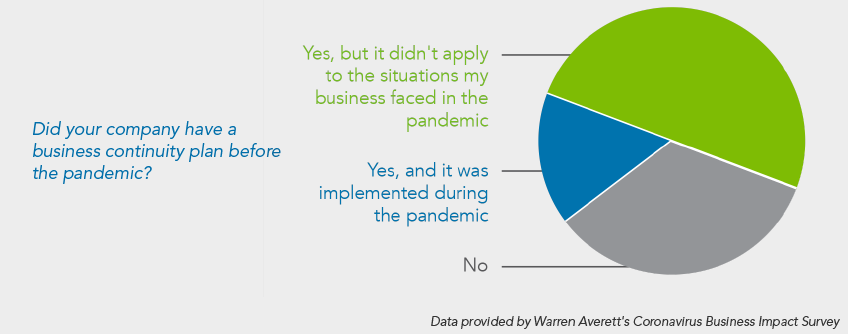How to Create a Business Continuity Plan for Your Florida Business

Businesses rarely get advanced notice that a disaster or business interruption is about to strike. That's why a business continuity plan is vitally important to all businesses.
A business continuity plan is a series of protocols designed to ensure that business operations can continue during a disruptive event.
It typically covers processes and procedures for communicating with employees and clients, recovering lost data, repairing failed systems or technologies and quickly resuming typical business functions.
When the COVID-19 pandemic struck, few business continuity plans were designed with a global pandemic in mind. In fact, 66% of businesses said they had a business continuity plan in place before the COVID-19 pandemic, but 76% of those businesses said their plan didn't apply to the challenges they faced as a result of the pandemic, rendering their business continuity plans ineffective.

So how can you create a business continuity plan that accounts for any type of disaster or unforeseen circumstance so that your business is prepared no matter what comes your way?
Business Continuity Planning Overview
Many businesses have a disaster recovery plan and therefore believe they're equipped for business continuity.
However, disaster recovery plans largely focus on restoring IT infrastructure after a crisis, and they typically don't address areas such as human resources, sales, marketing and customer relations. Disaster recovery is critical, but it's just one component of a complete business continuity plan.
Whether the pandemic convinced you to implement a business continuity plan or your current plan needs an update, we've outlined a business continuity plan checklist to help you create an effective plan—no matter what business interruption may strike.
A Business Continuity Plan Checklist
Every business is unique, so every business continuity plan should address the specific people, processes and technologies that are essential to the organization.
Still, the following business continuity plan checklist can offer general steps that any company should take to institute crisis-averting measures.
Creating and maintaining a business continuity plan is no small feat, but the process will ensure your organization is safer today and ready for any future disruptions or disasters that may occur.
1. Assess your business processes
Assessing your business's operations and determining which processes are vulnerable in the event of a disaster is the best start to any business continuity plan checklist. This helps you set the scope of your plan and identify the departments and staff members who need to be involved in creating it and carrying it out.
2. Conduct a business impact analysis
What risks would your company face if any significant disruption were to occur? Consider physical, financial and operational implications of a disaster. Create a list of potential impacts, such as damage to the company's reputation, loss of sales, regulatory fines, etc. Whenever possible, quantify these risks with a cost.
3. Create prevention strategies
Based on your business impact analysis, detail any preventative measures that can be taken before a disruptive event occurs. This may include identifying remote working solutions and ensuring critical data is on the cloud.
4. Identify critical equipment
In your business continuity plan, specifically identify the equipment necessary to sustain business operations, such as generators, laptops, servers, cell phones, personal protection equipment, facilities, specialized machinery or equipment, emergency medical supplies and more.
Determine whether you can have that equipment at hand or access it quickly from a vendor in the event of a disruption.
5. Determine how to access crucial data
Resuming business operations requires access to essential data, so you must know where and how that data is stored. Consider instituting policies that allow for consistently backing up your data, securing your data and cloud computing.
6. Plan to communicate with employees
In the event of a disruption or disaster, the organization's leaders must communicate with employees and be transparent about the risks and plans at hand.
Identify in your business continuity plan who will be responsible for messaging, who will be in charge of reaching out to employees and how the organization will contact staff members during different scenarios (email, phone, video conferencing, social media, etc.). Regular, transparent communications in a crisis build trust and motivate employees to remain productive.
7. Plan to communicate with clients and customers
Address how you will distribute information to and collect information from clients during and following a disaster.
In some cases, your customers and clients may be facing the same disruption event. How will you focus on recovering your own operations while also dealing with higher volumes of calls, emails and client needs?
It's crucial to maintain open lines of communication and keep customers apprised of any impacts on product or service delivery.
8. Provide ongoing training and conduct annual reviews
Any business continuity plan checklist is incomplete without training and reviews.
Once your business continuity plan is complete, make sure all employees have the training they need to carry out the plan. Training should include a basic overview of procedures, as well as exercises to test them out.
At least annually, review your plan to ensure it is still aligned with your current people, processes and technologies.

Go Beyond a Business Continuity Plan Checklist to Create a Course Specific for Your Organization
If you don't yet have a business continuity plan, now is the time to put one in place. If you already have a plan, don't forget to test it and continue to think proactively about how you can be better prepared for future uncertainties.
This business continuity plan checklist can only go so far to guide your organization towards creating the right course of action for you. Because business continuity plans are specific to each organization and their financial, physical and operational scenarios, the process of creating one can feel very abstract.
If reviewing this business continuity plan checklist leaves you questioning what your next move should be, Warren Averett's trusted advisors can help. Contact your Warren Averett advisor today for guidance on the business continuity and disaster recovery planning process, or ask a member of the team to reach out to you.

This article was originally published on August, 25, 2020 and most recently updated on April 4, 2022.
Back to Resources
Source: https://warrenaverett.com/insights/business-continuity-plan-checklist/
Postar um comentário for "How to Create a Business Continuity Plan for Your Florida Business"